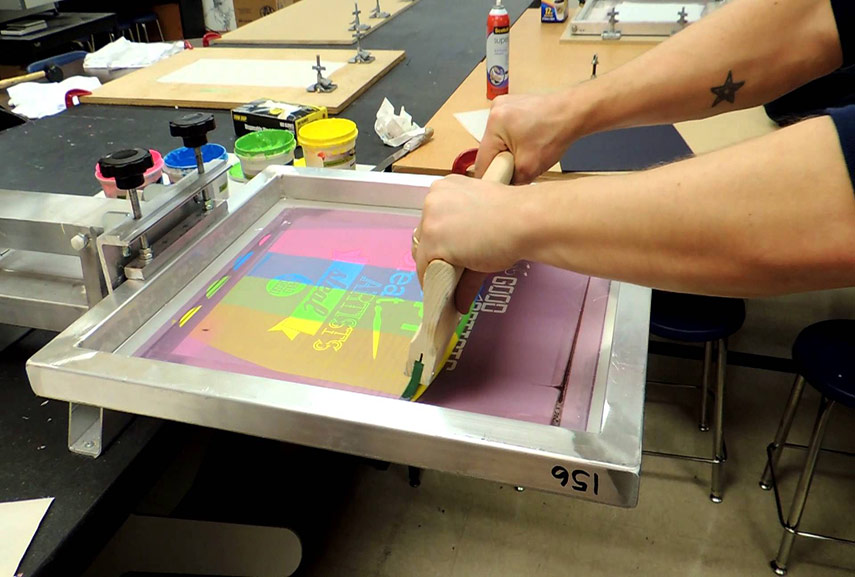The Crucial Guide to Understanding Screen Printing and Its Versatile Utilizes
Screen printing has a rich history that dates back to ancient times, progressing right into an innovative strategy used throughout different sectors today. This overview explores the complexities of the screen printing procedure, describing its applications in marketing, style, and home décor - 10:9 Design Abilene. Comprehending these basics can open creative capacity for both commercial and creative jobs. The complying with sections will reveal vital ideas and methods to boost one's screen printing ventures
The Background of Screen Printing
Although screen printing has roots that map back centuries, its development reflects the imaginative and technological advancements of numerous cultures. Coming from ancient China, the technique was originally utilized for decorating textiles and later spread to Japan, where it came to be indispensable to Ukiyo-e woodblock printing. The method shifted to Europe in the 18th century, where it obtained popularity among craftsmens and business printers. The innovation of photo emulsion in the 20th century reinvented screen printing, enabling for even more detailed layouts and better efficiency. Artists like Andy Warhol further pushed its appeal, using the medium to create iconic jobs that mixed commercialism and fine art. By the late 20th century, screen printing had developed itself as a functional technique, employed in vogue, advertising and marketing, and great art. Today, it continues to evolve, integrating digital modern technology and broadening its applications across different industries.
The Screen Printing Process Explained
Screen printing transforms creative visions right into concrete designs through a series of specific steps. A picture is created and after that moved onto a screen, typically made of fine mesh material stretched over a structure. A light-sensitive solution is put on the screen, which is revealed to light, hardening in locations not covered by the photo. After rinsing the unhardened solution, a pattern is formed.
Next off, the screen is put over the substrate, whether it be textile, paper, or another product. Ink is after that pressed via the open areas of the stencil making use of a squeegee, transferring the design onto the substrate listed below. This procedure can be duplicated for numerous shades, needing different displays for each and every hue. The published product is cured using warmth to ensure the ink sticks correctly, resulting in a resilient, lively style all set for use.
Kinds of Screen Printing Techniques

Additionally, specialty methods, such as discharge screen printing, eliminate color from the fabric to produce softer prints, while aluminum foil screen printing applies metal foil to achieve a shiny surface (10:9 Design near me). Each technique provides unique features, accommodating various innovative needs and production scales, ultimately broadening the possibilities within the screen printing domain
Applications of Screen Printing in Numerous Industries

Additionally, the signage and marketing industries use screen printing for producing attractive screens and banners. This technique permits for bold shades and detailed designs that record interest. In electronics, screen printing is employed for using conductive inks to circuit boards, vital for part links. In addition, the home décor sector embraces screen printing to generate distinct designs on textiles and wall art. Generally, screen printing works as a vital tool throughout varied areas, boosting products with personalized and aesthetically enticing graphics.
Tips for Successful Screen Printing Projects
While carrying out a screen printing task, cautious attention to information can considerably boost the last result. First, picking top quality products is important; this consists of the screen, inks, and substratums. Utilizing suitable mesh matters can impact ink deposition and detail resolution. Prep work is equally important; extensive cleansing of displays and correct direct exposure times ensure crisp prints.
Next off, exact enrollment is essential for multi-color prints. Making use of positioning tools can assist accomplish exact layering. Furthermore, testing prints on scrap products before production helps recognize potential problems without wasting sources.

Regularly Asked Questions
What Products Are Best for Screen Printing on Fabric?
Cotton and polyester blends are perfect for screen printing on textile due to their durability and ink absorption. In addition, specialty textiles like silk or canvas can create special textures and coatings, boosting the total style high quality.
Exactly how Do I Tidy and Maintain Screen Printing Tools?
To cleanse and preserve screen printing equipment, one should consistently clean screens with appropriate solvents, examine squeegees for wear, lube moving parts, and store all items in a dry, dust-free environment to lengthen their life expectancy.
What Are the Environmental Effects of Screen Printing?
Screen printing can have substantial ecological effects, more info including chemical waste from inks and solvents, water usage throughout cleaning processes, and power intake. Environmentally friendly products and sustainable methods are vital for reducing these unfavorable results.
Can Screen Printing Be Done in your home Efficiently?
Screen printing can be efficiently done at home with the right materials and methods. Hobbyists can develop top quality prints, though success relies on their skill level, equipment, and understanding of the process involved.
What Are the Costs Linked With Starting a Screen Printing Service?

Beginning a screen printing service involves costs for devices, materials, and work area. First expenditures typically vary from a couple of hundred to numerous thousand bucks, relying on the scale, quality of equipment, and desired manufacturing capacity.
Screen printing has an abundant background that dates back to ancient times, developing into an advanced strategy utilized throughout numerous sectors today. An additional technique, rotary screen printing, uses round screens, promoting continuous printing on textile rolls, thereby enhancing effectiveness for massive manufacturings. Additionally, specialized strategies, such as discharge screen printing, eliminate color from the fabric to produce softer prints, while aluminum foil screen printing uses metal foil to attain a glossy coating. In the style sector, screen printing is widely used to develop lively designs on apparel, making it possible for brands to showcase their distinct styles. Cotton and polyester blends are excellent for screen printing on material due to their durability and ink absorption.